
Those of you following this blog on garden design may be crossing your eyes and feeling like blacking out this past few weeks. I have gone on about the elements of design-maybe too long. I try the best I can to illustrate, and not instruct. My ability to peel off into a snow bank, or winter weary meadow, is a little compromised right now, so I have been photographing close to home and on solid ground. When I am done apologizing, I am still left with the conviction that a clear understanding of the elements of design applies to any 4 square feet on your planet-your dining room, your kitchen, your garden, your driveway. No kidding. I hope to illustrate and not instruct- via this very small property I landscaped some years ago. Though the front door is massive, the property square footage is very small. No need to put the landscape under a microscope-the house came with an intensely small space. Every move counts.
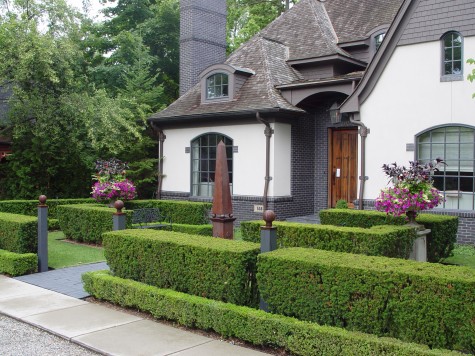 This landscape relies much on a configuration of evergreens that stand fast every month of the year. Whatever the weather. My original client sold this house some time ago-my new clients are grade A stewards-any beautiful old landscape is a direct result of the intensive care of the present, and not age-this idea via the essays of Henry Mitchell. The yew hedge fence, and its black stained posts and rusted finials, echo the rusted obelisk placed front and center. A pair of pots on pedestals placed side to side, and planted for each season-who knew a pair of pots could rule a garden like these do.
This landscape relies much on a configuration of evergreens that stand fast every month of the year. Whatever the weather. My original client sold this house some time ago-my new clients are grade A stewards-any beautiful old landscape is a direct result of the intensive care of the present, and not age-this idea via the essays of Henry Mitchell. The yew hedge fence, and its black stained posts and rusted finials, echo the rusted obelisk placed front and center. A pair of pots on pedestals placed side to side, and planted for each season-who knew a pair of pots could rule a garden like these do.

It cannot be 20 feet from the street to the front door. I persuaded my clients to install a wood sidewalk-each length of pressure treated lumber was routed to resemble bricks-after one year of weathering, I stained them black. There was a time when roads were made of wood-that history is not especially pertinent to this design. What is pertinent is what one sees. A look needs to stand on its own, no matter any history or explanation. A short walk needs a distinguising feature-a new thought. Any gesture, no matter how short, can illustrate a love of the out of doors without instructing. A wood sidewalk-different. Still looking great after all these years-this I love.
 The rear yard-a patch of ground that would comfortably accomodate 12. The simple solution-gravel the entire area. Plant four lindens at the four corners, to provide some natural shade corner to corner. The steps to the back door-I did not switch materials. Simple in a small space means the repetition of one material amounts to the impact of many hands to the same end. These corten steel risers retain the gravel surface steps. On the floor, everywhere else, gravel.
The rear yard-a patch of ground that would comfortably accomodate 12. The simple solution-gravel the entire area. Plant four lindens at the four corners, to provide some natural shade corner to corner. The steps to the back door-I did not switch materials. Simple in a small space means the repetition of one material amounts to the impact of many hands to the same end. These corten steel risers retain the gravel surface steps. On the floor, everywhere else, gravel.
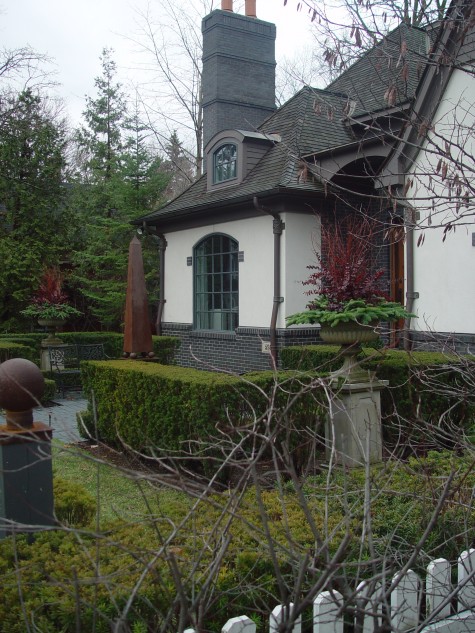 When winter comes, leaves are shed. Shrubs of great volume are but a shadow of their summer self. The evergreens keep on going on- but what is remarkable here, given it is mid-January? Those two pots on pedestals, stuffed with materials for the winter, carry the day. The design elements in play here are many. No need to know the words, if you can see.
When winter comes, leaves are shed. Shrubs of great volume are but a shadow of their summer self. The evergreens keep on going on- but what is remarkable here, given it is mid-January? Those two pots on pedestals, stuffed with materials for the winter, carry the day. The design elements in play here are many. No need to know the words, if you can see.
 No matter the late lame snow, the design elements of this garden are strong; grown in. There is a living presence, and pattern, that pleases the eye. Their garden ornament takes on a bigger role in the half year we know as winter. I like my front garden and landscape to be eye-ready, no matter the season.
No matter the late lame snow, the design elements of this garden are strong; grown in. There is a living presence, and pattern, that pleases the eye. Their garden ornament takes on a bigger role in the half year we know as winter. I like my front garden and landscape to be eye-ready, no matter the season.
Once spring comes, we change out those pots. Their idea of spring brings the neighborhood to life -many houses on this street do much the same. Designing thoughtfully to the betterment of all -what a great idea. Those elements that make a difference-take some time to look, and make them work for you.


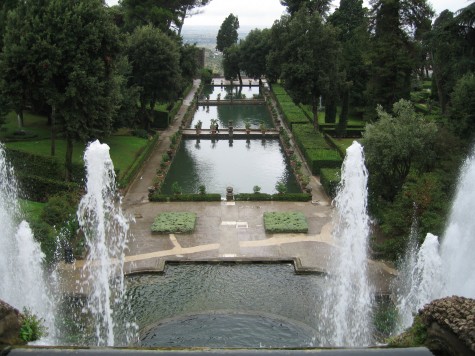
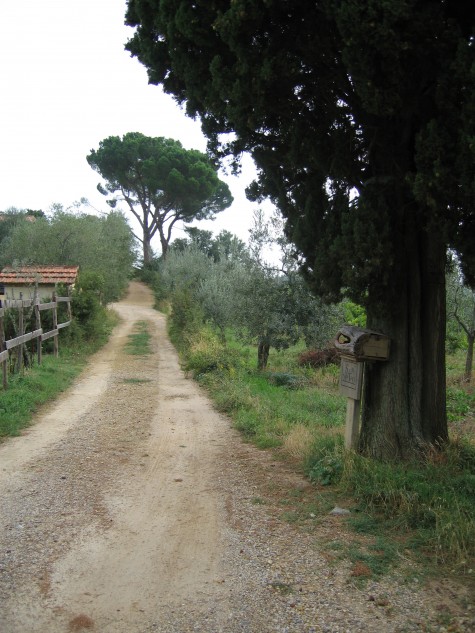


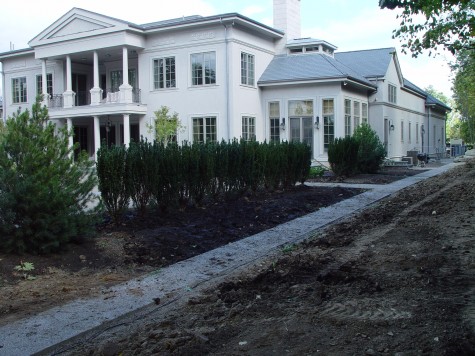




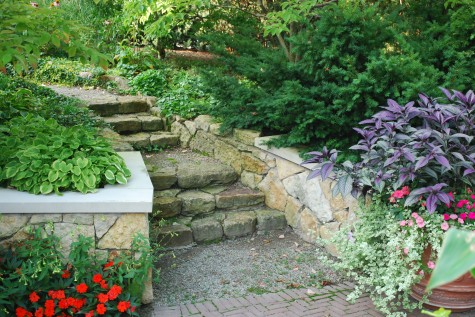
 As my layout table has its first new coat of paint in 14 years, all the prints I’ve had stored there are piled up in my office. OK, I couldn’t resist taking a look before I put them back in storage. Some of them entertain me-I can see exactly what was influencing me at the time. The roll of drawings for the Bluewater project was just that-drawings. These unpolished sketches of landscape elements for a commercial project were highly conceptual-and certainly predate any computer programs that are now readily available to designers.
As my layout table has its first new coat of paint in 14 years, all the prints I’ve had stored there are piled up in my office. OK, I couldn’t resist taking a look before I put them back in storage. Some of them entertain me-I can see exactly what was influencing me at the time. The roll of drawings for the Bluewater project was just that-drawings. These unpolished sketches of landscape elements for a commercial project were highly conceptual-and certainly predate any computer programs that are now readily available to designers.  Land forms have always been of great interest to me. A big chunk of my library deals with mazes and labyrinths, land sculpture and earthworks. Robert Smithson’s 1970 sculpture “Spiral Jetty”, constructed in 6 days on a leased piece of the Great Salt Lake in Utah, is now completely landlocked as the lake is so low. The sculpture spent 20 years or better completely submerged. The sculpture has presented in many forms over the past 40 years. I have always admired it; no doubt this conceptual drawing of a maze half in and half out of some water was directly inspired by Smithson’s work.
Land forms have always been of great interest to me. A big chunk of my library deals with mazes and labyrinths, land sculpture and earthworks. Robert Smithson’s 1970 sculpture “Spiral Jetty”, constructed in 6 days on a leased piece of the Great Salt Lake in Utah, is now completely landlocked as the lake is so low. The sculpture spent 20 years or better completely submerged. The sculpture has presented in many forms over the past 40 years. I have always admired it; no doubt this conceptual drawing of a maze half in and half out of some water was directly inspired by Smithson’s work.  Another favorite-the land form drawings of Hans Dieter Schaal in his book “Landscape as Inspiration”. Inspired indeed. His sprawling and energetic drawings of natural forms exposed me to an entirely different way of thinking about dirt and nature. I had never seen landscape spaces rendered in this way before. I was equally taken with the beauty of the drawings. They are by no means scaled prints, they are gestural and interpretive marks on a page. This work inspired me to take up a marker and put it to a page, and see what happens. I refer to his book regularly.
Another favorite-the land form drawings of Hans Dieter Schaal in his book “Landscape as Inspiration”. Inspired indeed. His sprawling and energetic drawings of natural forms exposed me to an entirely different way of thinking about dirt and nature. I had never seen landscape spaces rendered in this way before. I was equally taken with the beauty of the drawings. They are by no means scaled prints, they are gestural and interpretive marks on a page. This work inspired me to take up a marker and put it to a page, and see what happens. I refer to his book regularly.  Any reference to natural forms intrigues me. A log twig bridge over Bluewater’s man-made lake seemed like just the right combination of architecture and natural materials. Buck shakes his finger at me when I design with no regard for construction, but I still think a little free spirited doodle drawing has its place. A sketch that seems to be going no where is easily discarded-provided you have not spent so much time with it that you have become attached. It is difficult to be objective about one’s own work-so I try to work fast at the conceptual stage. Anything I have invested a lot of time and work in can be hard to trash-even when trash it I should.
Any reference to natural forms intrigues me. A log twig bridge over Bluewater’s man-made lake seemed like just the right combination of architecture and natural materials. Buck shakes his finger at me when I design with no regard for construction, but I still think a little free spirited doodle drawing has its place. A sketch that seems to be going no where is easily discarded-provided you have not spent so much time with it that you have become attached. It is difficult to be objective about one’s own work-so I try to work fast at the conceptual stage. Anything I have invested a lot of time and work in can be hard to trash-even when trash it I should. 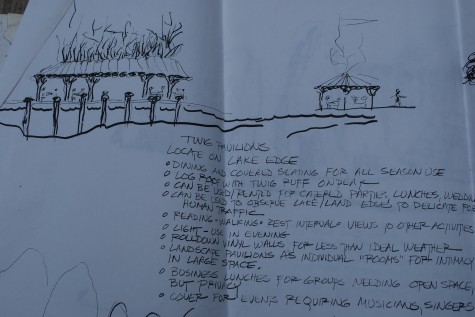 None of these drawings would convince a client to commit their time and money. But they might convince a client that there was a reservoir of ideas from which something of interest might emerge. If you don’t believe your designer is a person of interest, then a collaboration on your project is unlikely. If you are designing for yourself, drawings can bring ideas to the surface you didn’t know you had. Keeping a waste basket handy can be a comfort!
None of these drawings would convince a client to commit their time and money. But they might convince a client that there was a reservoir of ideas from which something of interest might emerge. If you don’t believe your designer is a person of interest, then a collaboration on your project is unlikely. If you are designing for yourself, drawings can bring ideas to the surface you didn’t know you had. Keeping a waste basket handy can be a comfort! I am happy to have these drawings, not for their design, but for their energy. Being the fan of science that I am, I wholly subscribe to the notion that everything in motion tends to stay in motion-and what’s at rest tends to stay still. This applies as much to a design sensibility as it does to the physical world. Inertia being gravity that has gotten the upper hand, I make the effort to feed whatever energy I have regularly.
I am happy to have these drawings, not for their design, but for their energy. Being the fan of science that I am, I wholly subscribe to the notion that everything in motion tends to stay in motion-and what’s at rest tends to stay still. This applies as much to a design sensibility as it does to the physical world. Inertia being gravity that has gotten the upper hand, I make the effort to feed whatever energy I have regularly.  This drawing suggests at least 6 different ideas. They have similar elements, but are disconnected from each other. At the end of a series of drawings comes the integration phase. How visual and sculptural elements relate to each might be more important than any given piece. That relationship provides for good flow and rhythm. I see lots of landscapes that have good bits, but no flow. In the print, I plan for the transition between one space and another to have its own space.
This drawing suggests at least 6 different ideas. They have similar elements, but are disconnected from each other. At the end of a series of drawings comes the integration phase. How visual and sculptural elements relate to each might be more important than any given piece. That relationship provides for good flow and rhythm. I see lots of landscapes that have good bits, but no flow. In the print, I plan for the transition between one space and another to have its own space. 